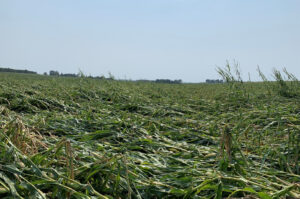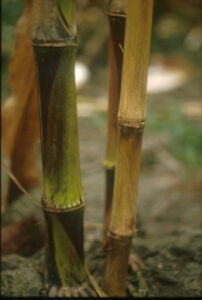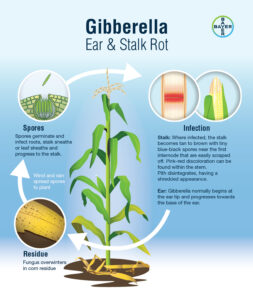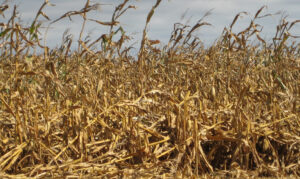Corn standability is dependent on a combination of plant quality, stalk strength, and root strength. Stalk lodging is the breakage of the stalk below the ear. Root lodging is a result of the inability of the root system to anchor the plant and keep it vertical, which causes the stalks to lodge. Corn standability and stalk lodging are often talked about interchangeably to describe down corn at harvest. Severe lodging is a widespread problem for corn growers in the US and Canada that leads to annual yield losses of 5 to 25% in the US, and which may also reduce the quality of the harvested grain.
Predicting the occurrence of stalk lodging is difficult because lodging may be caused by the combined effects of several factors. One field may develop stalk rot while an adjacent field planted with the same corn product does not, or part of a field may have severe stalk lodging while the rest of the field is still standing.
The main causes of corn standability problems at harvest include:
- Severe weather
- Stalk and root deterioration by cannibalization due to stress late in the season
- Stalk deterioration due to stalk rot-causing pathogens
- Insect feeding
- Corn product with insufficient root or stalk strength
Severe weather is a major cause of late-season stalk lodging. High wind alone can devastate even a healthy corn crop in minutes, but when the wind event is accompanied by heavy rain standability problems can increase even further (Figure 1). When severe weather hits, it can cause stalk breakage, root lodging, or a combination of both depending on the growth stage, corn product, and soil moisture at the time of the event.

Figure 1. Lodged corn after a wind event.
An early season snowstorm with high winds can also cause standability issues, as the harvest window is often delayed after one of these events.
Plant Stress Factors That Increase Stalk Lodging
Crop stress factors that favor stalk lodging include:
- Foliar disease
- Insect damage
- High plant populations (competition causes plants to grow tall and have thin stalks)
- Extreme temperatures
- Moisture stress (either excessive moisture or drought)
- Infected crop residue
- Plant injury, which includes hail injury to the stalks
- Cloudy weather during grain fill
- Loss of healthy green leaf area due to leaf diseases or hail
- Continuous corn (can increase insect and disease pressure)
- Nutrient imbalance and deficiencies
Stalk Rot
One of the major causes of stalk lodging is stalk rot. Stalk rot decreases a corn plant’s ability to resist external stress by weakening the stalk tissue, resulting in greater susceptibility to stalk breakage and lodging. The incidence and severity of stalk rot issues depends on the susceptibility of the corn product, the presence of the stalk rot organism, and whether the environment is conducive to disease development. Additionally, during grain fill plants that are under post-pollination stress will produce less sugar in the leaves than healthy, non-stressed corn plants. Foliar stress can reduce the available photosynthetic area, thus reducing the amount of sugars produced by the plant. The developing ear is usually prioritized when the plant allocates available sugars, so if adequate sugar stores are not available then stored sugars in the lower stalk and roots are remobilized to the ear during ear fill (plant cannibalization). This remobilization can deprive the lower stalk and roots of sugars to the point that their defense mechanisms against stalk rot break down.
Pathogens that Cause Stalk Rot
Almost any kind of plant stress, occurring at almost any time during the growing season, can predispose the corn plant to invasion by stalk rot fungi. This is why these pathogens are called opportunistic pathogens, meaning they primarily infect injured, stressed, or dead and dying plants. Although corn products vary in their genetic tolerance to stalk rot organisms, a small amount of stalk rot may occur in every product every year. Stress on a plant slows the rate of photosynthesis, which in turn slows the plant’s growth rate. Some of the common stalk rot pathogens include:
- Anthracnose stalk rot, caused by the fungus Colletotrichum graminicola
- Charcoal rot, caused by the fungus Macrophomina phaseolina
- Diplodia stalk rot, caused by the fungus Stenocarpella maydis (Figure 2)
- Fusarium stalk rot, caused by the fungus Fusarium verticilliodes (Figure 3)
- Giberella stalk rot, caused by the fungus Fusarium graminearum2 (Figure 4)

Figure 2. Diplodia Stalk Rot

Figure 3. A healthy corn stalk (left) and a stalk with fusarium stalk rot (right)
Stalk Rot Management
Stalk rot disease development is strongly favored by any stress to the plant, so it is important to manage the crop to minimize potential stress whenever possible. While many stresses are out of the grower’s control, some crop stresses can be minimized with appropriate preventive management. For example, when significant leaf blight occurs in the upper canopy, the risk of stalk rots increases. Foliar fungicide applications will not necessarily prevent stalk infection but may protect the plant against foliar diseases that cause the loss of photosynthetic leaf area. If left unmanaged, this loss of leaf area may lead to remobilization of sugars from the stalk tissue, which can ultimately compromise stalk integrity. Other management steps include choosing corn products with tolerance to stalk rot diseases, when available, and the use of tillage to promote degradation of infected residue. Though note that tillage has had mixed results on reducing the occurrence of stalk rot problems.

Figure 4. Giberella ear and stalk rot infection cycle
Corn Borers
Another major cause of stalk lodging is damage from above-ground-feeding insects, such as the larvae of the European and Southwestern corn borers. Corn borer larvae bore into the stalk, reducing stalk strength and potentially causing standability issues.
Corn Borer Management
Corn products that have an above-ground European-corn-borer (ECB) and Southwestern-corn-borer (SWCB) protection trait offer very good season-long protection, greatly reducing the potential for corn-borer-induced stalk lodging. All corn products should be scouted for ECB and SWCB, but it is particularly important to scout corn products that do not have an above-ground insect protection trait. One way to identify a potential ECB or SWCB problem is to scout for egg masses that have been laid by the adult moth on the underside of the corn leaf. Prioritize fields with later development, as female moths prefer plants with green silks. Start scouting in mid to late July for second-generation egg masses, which is the insect generation that can cause stalk-boring and stalk-lodging problems. The control window is very small, so control will need to be applied as the egg masses are laid but before the larvae reach their third instar. At this growth stage the larvae start to bore into the stalks and there is no available control that will kill the larvae after they have entered the stalk. To determine if the number of egg masses scouted has reached a level that economically justifies treatment for non-above-ground insect protected corn products, use a cost-benefit analyses worksheet for your production area. Many states offer a cost-benefit analysis worksheet for corn borer insect pressure. Choose your sampling areas to adequately reflect differences in soil types, planting dates, soil drainage patterns, corn products, weed pressure, rainfall, and soil fertility levels. Later-planted corn in a production area can attract heavier insect pressure, including ECB and SWCB, which can then cause additional potential stalk-feeding pressure.
Root Lodging
Corn root lodging occurs when root growth is unable to anchor the plant against the forces of strong winds and abundant rainfall. Factors that can contribute to root lodging include:
- The selected corn product
- Soil and environmental conditions
- Insect damage (likely rootworms, but potentially nematodes)
- Herbicide injury
Root lodging can happen throughout the growing season. The stalk can often straighten back up when root lodging happens early in the plant’s development, but with the plants “goose necking.” Goose necking can still cause some harvest problems, but not to the extent of later root lodging. If late root lodging occurs after pollination, the plants are less likely to straighten up (Figures 5A and 5B) and serious harvest problems can occur.

Figure 5A. Late-season root lodging in corn

Figure 5B. Early season goose necking in corn
Insect Root Feeders
Corn rootworms are a major pest that feed on nodal and brace roots, reducing the root mass and potentially causing root lodging. The corn rootworm life cycle consists of only one generation of rootworms per year, and the larval stage is the only growth stage that feeds on corn roots. Northern corn rootworm, western corn rootworm, and (in some areas) the Mexican corn rootworm potentially cause the most root-feeding issues in the Midwest. Corn rootworms problems most often to show up when:
- Continuous corn is grown
- The field has a heavy soil type (clay or loamy soil type)
- The field was weedy with foxtail grasses, ragweed, or volunteer corn the previous year
- The field developed late the previous year and had green silks after other fields, making it very attractive for female moths laying eggs
- In areas with the diapausing northern corn rootworm variant, fields that were planted to corn two growing seasons ago may be at risk
- In areas with the soybean-laying western corn rootworm variant, corn fields that were planted to soybean in the previous season may be at risk
Corn Rootworm Management
The adult female rootworm beetles must lay their eggs in the field before corn is planted for rootworm larvae to be a problem in a corn field, as the eggs overwinter in the soil. Rootworm adults preferentially lay their eggs in a corn field to improve the feeding success of the larvae that will hatch the next year, which is why most rootworm problems occur in corn-on-corn rotations. Therefore, the first management option that is often used is crop rotation. Do not plant corn on acres that were planted to corn the previous year. This is still a very good control option, except in two different areas where two rootworm variant biotypes have evolved that can work around this management strategy.
The extended diapause northern rootworm variant, the eggs of which remain dormant for an additional year before hatching, and the western rootworm variant, which lays its eggs in a soybean field, are not controlled by this conventional corn rotation strategy. More information about corn rootworm management is available at https://www.cropscience.bayer.us/articles/bayer/management-corn-rootworm-complex. Other rootworm control options include soil-applied insecticides and the use of pyramided corn-rootworm-protected corn products. A pyramided corn product is one that has been genetically modified to produce at least two proteins directed toward resisting a single pest. It is important to avoid using the same insecticides or the same rootworm-protected product year after year, as local rootworm populations could potentially develop resistance to a specific, continually used product. Finally, an adult rootworm beetle control program can be used to reduce the following year’s rootworm pressure in a continuous corn production field.
Harvest Management
Growers should start scouting their fields shortly after pollination, checking for any factors that could cause corn standability problems, which will allow growers to create a preliminary harvest plan for minimizing yield losses. A pre-harvest inspection should then take place again in late August to early September to estimate the amount of stalk rot development, to determine the extent of insect damage to stalks and roots, and to finalize the harvest order. Observations should be made within the field, away from outside rows.
The pinch test and the push test can both be used to estimate how much stalk rot is present in a field. To use the pinch test, pinch the stalks of several random plants both near the ground and up toward the ear. A hollow stalk that collapses easily indicates advanced stages of stalk rot or corn borer damage. To use the push test, check at least 100 plants and push the top of each plant away from yourself by about 30 degrees.
A plant passes the test if it returns to an upright position. If more that 10 % of the plants tested in a given area do not return to an upright position, that area may need to be harvested first to prevent stalk lodging from impacting the harvest.
The goals of pinch testing or push testing are to determine if any corn standability problems are only in one area of the field or if they are spread evenly throughout the field. Is only one field affected, or are all fields affected? Once you have determined the extent of the problem, consider the following harvest options:
- Harvest the affected areas first to prevent lodged fields from remaining unharvested any longer than necessary, provided the grain is physiologically mature.
- Harvest the affected areas slower than usual.
- A ground speed of two mph is usually adequate for harvesting lodged corn. Harvesting at a slow speed increases the grower’s ability to pick up lodged ears that might otherwise be missed.
- Gathering-chain speeds and snapping-roll speed will need to be adjusted to correspond with the reduced speeds to maintain the normal relationship between the gathering chain, snapping roll, and ground speed.
- Combine snouts and gathering chains should be run as close to the ground as possible to pick up the lodged corn.

Figure 6. Corn stalk lodging
- If lodging is severe, harvest against the direction of the lodging to increase the chances of picking up lodged ears.
- For example, if the corn plants are lodged toward the east, come into the field from the east and harvest in an east-west row direction. Harvesting this field from the west will only lodge the plants further, making it almost impossible to pick up the ears.
- Some growers have indicated that they adjust the gathering chains and the rolls inward as closely as possible to adequately grip rotten stalks lacking a center core. These stalks collapse to a thickness of approximately 1/8 inch when squeezed.
- Harvest using different corn heads and head attachments, like a corn reel, that are designed to bring lodged stalks into the combine head to reduce losses and speed up harvest.
Post-Harvest Considerations
While utilizing harvest management options can help reduce the harvest losses that a grower incurs during the current growing season, it is important
to evaluate why certain fields or areas of fields lodged (Figure 6). In many situations it is very difficult for a grower to determine exactly what issue, or combination of issues, caused a corn-standability problem. Environmental stress factors increase the potential for stalk lodging in a corn crop, such as high plant populations, extremes in soil moisture, nutrient deficiencies and/or imbalances, insect damage, cropping sequence, and corn product susceptibility. Consider if the correct choices were made when selecting the best corn product, proper fertility levels, plant populations, pest control, and cultural practices. What management options can be changed to avoid these problems in future years? Additionally, your local agronomist or seed professional are available to help determine the causes of any corn standability problems and should preferably be consulted before harvest.
